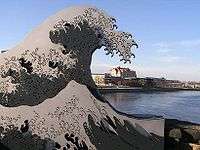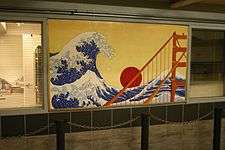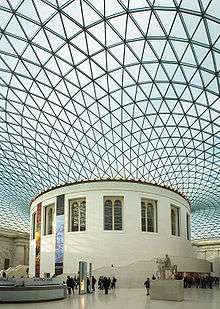The Great Wave off Kanagawa
 | |
| Artist | Katsushika Hokusai |
|---|---|
| Year | 1830-1833 |
| Type | color woodblock |
| Dimensions | 25.7 cm × 37.8 cm (10.1 in × 14.9 in) |
The Great Wave off Kanagawa (神奈川沖浪裏 Kanagawa-oki nami ura, "In the well of a wave off Kanagawa"/"Under the wave off Kanagawa"), also known as The Great Wave or simply The Wave, is a woodblock print by the Japanese ukiyo-e artist Hokusai. It was published sometime between 1830 and 1833[1] in the late Edo period as the first print in Hokusai's series Thirty-six Views of Mount Fuji (富嶽三十六景 Fugaku sanjūrokkei). It is Hokusai's most famous work, and one of the best recognized works of Japanese art in the world. It depicts an enormous wave threatening boats off the coast of the prefecture of Kanagawa. While sometimes assumed to be a tsunami, the wave is, as the picture's title suggests, more likely to be a large rogue wave.[2] As in all the prints in the series, it depicts the area around Mount Fuji under particular conditions, and the mountain itself appears in the background.
Impressions of the print are in many Western collections, including the Metropolitan Museum of Art in New York City, the British Museum in London, the Art Institute of Chicago, the Los Angeles County Museum of Art, the National Gallery of Victoria in Melbourne,[3] and in Claude Monet's house in Giverny, France, among many other collections.
Context
Ukiyo-e art
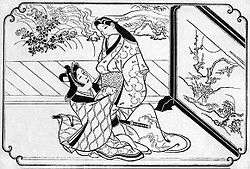
Ukiyo-e is a genre of Japanese woodblock prints (or woodcuts) and paintings, principally produced between the 17th and the 20th centuries and featuring motifs of landscapes, tales from history, the Kabuki theater, and pleasure quarters.
The technique of printing from blocks of wood was introduced to Japan in the 8th century from China and was used principally for the illustration of Buddhist texts.[4] From the 17th century the technique began to be used for the illustration of poems and romances.[4] It was this period that really saw the rise of the style known as ukiyo-e, which reflected the lives and interests of the lowest classes of society: merchants, artists and rōnin, who were developing their own art and literature in urban areas such as Edo (today's Tokyo), Osaka and Sakai, in a movement later called ukiyo, the floating world.[5] It was the novelist Asai Ryōi who in 1661 defined the movement in his book Ukiyo-monogatari ("Narrative of the Floating Life"): "living only for the moment, savouring the moon, the snow, the cherries in flower and the leaves of the maple, singing songs, drinking sake and enjoying simply floating, indifferent to the prospect of impending poverty, optimistic and carefree, like a pumpkin dragged along by the current of the river."[6]

Thanks to movements such as the ukiyo literature and the prints, the populace began to have more contact with artistic movements. Around the middle of the 17th century the artists began to reflect what was happening in the pleasure districts, kabuki, festivals and on journeys. The latter gave birth to guidebooks that described the highlights of the cities and countryside.[5]
Around 1670 the first of the great masters of ukiyo-e, Hishikawa Moronobu, appeared.[5] Moronobu began to produce prints on a single sheet showing flowers, birds, female forms and erotic scenes of a type known as shunga. This type of print was produced in black ink on white paper, and the artist could later add different colours by hand. By the end of the 18th century the techniques had been developed to allow printing of multi-coloured prints[4] known as nishiki-e.[7]
Technique

The first stage in creating a woodblock print was the artist creating a preparatory drawing, which would be taken to a horishi, or block carver, who would attach the painting to a block of wood (usually cherry),[7] and then carefully carve it away to form a relief of the lines of the image.[8] Finally, with all the necessary blocks (usually one for each colour),[7] a surishi or printer would produce the print by placing the printing paper on each block consecutively[9] The impression was produced by rubbing an implement called a baren over the back of the sheet.[10] This system could produce tonal variations in the prints.[4] There could be a great number of impressions produced, sometimes thousands, before the blocks wore out.[7]
Because of the nature of the production process, the final work was the result of a collaboration in which the painter generally did not participate in the production of the prints.[9]
Even though no law of intellectual property existed in Japan before the Meiji era, there was still a sense of ownership and rights with respect to the blocks (known as zōhan) from which the prints were produced. Rather than belonging to the artist, the blocks were considered the property of the hanmoto (publisher) or honya (publisher/bookseller) who could do with them as he wished. In some cases the blocks were sold or transferred to other publishers, in which case they became known as kyūhan.[11]
Hokusai

Hokusai was born in 1760, in Katsushika, a district in the east of Edo (now Tokyo). His birth name was Tokitarō,[12] and he was the son of a mirror maker to the shōgun. As he was never recognised for the purposes of inheritance, it is probable that his mother was a concubine.[13]
He began painting when he was six years old and at twelve his father sent him to work at a booksellers. At sixteen, he was apprenticed as an engraver and spent three years learning the trade. At the same time he began to produce his own illustrations. At eighteen he was accepted as an apprentice to the artist Katsukawa Shunshō, one of the foremost ukiyo-e artists of the time. After a year, his master gave him the name Shunrō, the name he used to sign his first works in 1779.[14]
Shunshō died in 1793, so by himself Hokusai began to study distinct Japanese and Chinese styles and some Dutch and French painting. During this period he mainly concentrated on producing surimono, or New Year's cards, and advertisements, scenes of daily life and landscapes.[15] In 1800 he published Famous Views of the Eastern Capital and Eight views of Edo, and also began to accept students. It was during this period that he began to use the name Hokusai;[15] he used more than 30 different pseudonyms during his life.[13]
In 1804 he became famous as an artist when, during a festival in Tokyo, he completed a 240m² painting[12] of a Buddhist monk named Daruma. Soon afterwards he appeared before the shōgun Tokugawa Ienari when he won a talent competition against an artist working the traditional Chinese style. Three years later he began work illustrating three books of the novelist Takizawa Bakin, with whom he argued. In 1812, the precarious economic situation forced him to publish a manual, Quick Lessons in Simplified Drawing and to travel to Nagoya and Kyoto to try to sign up students. In 1814, he published the first of fifteen volumes of sketches entitled Manga. These included things that interested him such as people, animals and the Buddha. In the late 1820s, he published Thirty-six Views of Mount Fuji, which proved so popular that he later added a further ten prints.[16]
Later works included Unusual Views of Celebrated Bridges in the Provinces, A Tour of the Waterfalls of the Provinces and One Hundred Views of Mount Fuji.[17] In 1839, just as his work started to be eclipsed by that of Andō Hiroshige, his studio burned down and most of his work was destroyed. He died at the age of 89,[18] in 1849.[19]
Some years before his death he is reported to have stated:
At the age of five years I had the habit of sketching things. At the age of fifty I had produced a large number of pictures, but for all that, none of them had any merit until the age of seventy. At seventy-three finally I learned something about the true nature of things, birds, animals, insects, fish, the grasses and the trees. So at the age of eighty years I will have made some progress, at ninety I will have penetrated the deepest significance of things, at a hundred I will make real wonders and at a hundred and ten, every point, every line, will have a life of its own.[20]
Image
Description
This print is a yoko-e, that is, a landscape format produced to the ōban size, about 25 cm high by 37 cm wide.[21]
The composition comprises three main elements: the sea whipped up by a storm, three boats and a mountain. It includes the signature in the upper left-hand corner.
The mountain
The mountain with a snowcapped peak is Mount Fuji, which in Japan is considered sacred and a symbol of national identity,[22] as well as a symbol of beauty.[23] Mount Fuji is an iconic figure in many Japanese representations of famous places (meisho-e), as is the case in Hokusai's series of Thirty-six Views of Mount Fuji, which opens with the present scene.
The dark color around Mount Fuji seems to indicate that the scene occurs early in the morning, with the sun rising from behind the observer, illuminating the mountain's snowy peak. While cumulonimbus storm clouds seem to be hanging in the sky between the viewer and Mount Fuji, no rain is to be seen either in the foreground scene or on Mount Fuji, which itself appears completely cloudless.[2]
Boats
In the scene there are three oshiokuri-bune, fast boats that are used to transport live fish[24] from the Izu and Bōsō peninsulas to the markets of the bay of Edo. As the name of the piece indicates the boats are in Kanagawa prefecture, with Tokyo to the north, Mt Fuji to the northwest, the bay of Sagami to the south and the bay of Tokyo to the east. The boats oriented to the southeast, are returning to the capital.
There are eight rowers per boat, clinging to their oars. There are two more passengers in the front of each boat, bringing the total number of human figures in the image to thirty. Using the boats as reference, one can approximate the size of the wave: the oshiokuri-bune were generally between 12 and 15 meters long, and noting that Hokusai reduced the vertical scale by 30%, the wave must be between 10 and 12 meters tall.[2]
The sea and the waves


The sea dominates the composition as an extending wave about to break. In the moment captured in this image, the wave forms a circle around the center of the design, framing Mount Fuji in the background.
Edmond de Goncourt described the wave in this way:
The drawing of the wave is a deification of the sea made by a painter who lived with the religious terror of the overwhelming ocean completely surrounding his country; He is impressed by the sudden fury of the ocean's leap toward the sky, by the deep blue of the inner side of the curve, by the splash of its claw-like crest as it sprays forth droplets.[25]
Andreas Ramos, a writer, notes:
[...]a seascape with Fuji. The waves form a frame through which we see the mountain. The gigantic wave is a yin yang of empty space beneath the mountain. The inevitable breaking that we await creates a tension in the picture. In the background, a small wave forming a miniature Fuji is reflected by the distant mountain, itself shrunk in perspective. The little wave is larger than the mountain. The small fishermen cling to thin fishing boats, slide on a sea-mount looking to dodge the wave. The violent Yang of nature is overcome by the yin of the confidence of these experienced fishermen. Strangely, despite a storm, the sun shines high.[25]
Signature
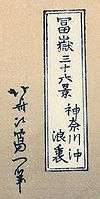
The Great Wave off Kanagawa has two inscriptions. The first, within a rectangular cartouche in the top-left corner is the series title: "冨嶽三十六景/神奈川冲/浪裏" Fugaku Sanjūrokkei / Kanagawa oki / nami ura, which translates as "Thirty-six Views of Mount Fuji / Offshore from Kanagawa / Beneath the wave". The second inscription, to the left, is the artist's signature: 北斎改爲一筆 Hokusai aratame Iitsu hitsu, ("From the brush of Hokusai, changing his name to Iitsu").[26]
Over his career, Hokusai used more than 30 different names, always beginning a new cycle of works by changing it, and letting his students use the previous name.
In his work Thirty-Six Views of Mount Fuji he used four distinct signatures, changing it according to the phase of the work: Hokusai aratame Iitsu hitsu, zen Hokusai Iitsu hitsu, Hokusai Iitsu hitsu and zen saki no Hokusai Iitsu hitsu.[27]
Design of the work



While composing the image, Hokusai experienced a period of great difficulty. Being in his 60s, in 1826 he was suffering serious financial problems, in 1827 it seems he had a major health problem (possibly a stroke), the next year his wife died, and in 1829 he had to rescue his grandson from bankruptcy, all of which drove him into poverty. Despite this, in 1830 he sent the grandson to the countryside with his father—adopted son of Hokusai—the financial repercussions would continue for several years: the period when he was creating Thirty-Six Views of Mount Fuji. It is perhaps because of those problems that the objective of the series seems to be contrasting the sacred Fuji with secular life.[2]
Hokusai decided upon the final design only after years of work and having created other sketches. There are two similar works, dated some 30 years before the publication of The Great Wave, that are its precursors. They are Kanagawa-oki Honmoku no zu and Oshiokuri Hato Tsusen no Zu,[28] both works with subjects identical to the Great Wave: a sailboat and a rowboat respectively. In both precursor works, the subjects are in the midst of a storm, beneath a great wave that threatens to devour them. An analysis of the differences between the two works and the Great Wave demonstrates the artistic and technical development of Hokusai:[29]
- In the two first designs the waves appear to be dense and uniform, they almost seem to be minerals. Their rigidity and verticality evoke the shape of a snow-capped mountain, while in the Great Wave the wave stands out because it is more active, dynamic, and aggressive, which make it threatening.
- The earlier images are very marked by the perspective traditionally used in Japanese painting, where the viewer sees the scene from a bird's-eye view. The Great Wave, on the other hand, is depicted in a more western perspective, giving the feeling that the wave will break on top of the viewer.
- In the earlier prints the horizon is in the middle, whereas in the Great Wave the horizon is so low that it forces the viewer's eye to the very center of the action.
- In the first two, there is a sail boat on the crest of the wave, as if it had managed to escape. Hokusai eliminated this element for the Great Wave, because it interfered with the dynamic of the curve or to make the image more dramatic.
- The two first prints have an uneven composition, lacking consistency, whereas the Great Wave only has two important masses: the wave itself, and the vanishing point beneath the wave.
- The wave shows the level of control that Hokusai had reached. The image, although simple in its design is, however, the result of a long process, a methodical reflection. The basis of this method were laid out by Hokusai in his 1812 work Quick lessons of simplified drawing, in which he explains that every object can be drawn using the relationship of the circle and square.
Some years thereafter, Hokusai returned to the image of the Great Wave when he completed the work Kaijo no Fuji, for the second volume of One Hundred Views of Fuji. In this print there is the same relation between the wave and the volcano, and the same burst of foam. In this image there are no humans nor boats, and the fragments of the wave coincide with the flight of birds. While in The Great Wave the motion of the wave is the opposite of Japanese reading-from right to left- in Kaijo no Fuji the wave as well as the birds move as a Japanese reader would expect.
Impressions of the woodblock
There are various impressions of this work throughout the world. Public collections holding the work include the Metropolitan Museum of Art in New York,[30] the British Museum in London,[1] the collection of Claude Monet in Giverny, France,[31] the Sackler Gallery,[32] the Guimet Museum[26] and the National Library of France.[33] A collection of Thirty-six Views of Mount Fuji woodblock prints, contained in the wellness spa of the Costa Concordia was lost during the collision of the ship on January 13, 2012.[34]
Some private collections also hold an impression, for example the Gale Collection in the United States.
It was private collectors during the 20th century that launched the woodblock print collections in these museums. For example, the impression in the Metropolitan Museum of Art comes from the collection of Henry Osborne Havemeyer, and was donated by Mrs. Havemeyer in 1929.[35] In the same way, the impression in the National Library of France was acquired in 1888 from the collection of Samuel Bing.[36] The impression in the Guimet Museum comes from the legacy of Raymond Koechlin, and has been in the museum since 1932.[37]
An impression from the Huguette Beres Collection was auctioned on March 7, 2003, the bidding reached 23,000 euros. The 46 prints from the series Thirty-Six Views of Mount Fuji were auctioned at Sotheby's in 2002 for a total of 1,350,000 euros.[38]
Differences between the versions

Given that the series was very popular when it was produced, printing continued until the woodblocks started to show significant wear. It is likely that the original woodblocks printed around 5,000 copies.[39]
It is possible to determine the degree of damage that the woodblocks had already sustained at the moment of printing any given impression by an analysis of two characteristic points. The first one is located just behind the right-side of the boat; in the impressions from worn woodblocks, the line is not continuous. The second point is on the left side of the signature box, where the lines that form it should be continuous.[39]
Given that many impressions have been lost, in wars, earthquakes, fires and other natural disasters, few early impressions survive in which the lines of the woodblocks were still sharp at the time of printing.[39] The condition of an impression, meanwhile, can be observed in the coloring of the sky. Well-preserved impressions, such as the Metropolitan Museum's, display a marked contrast between sky and clouds.
Non-original versions and derivative works
Like other well known Japanese prints, the Great Wave has been frequently copied using the same techniques, as well as reproduced by photo-mechanical means. These copies are often confused with the authentic original print.
The print is one of the most reproduced artworks in the world, and was one of the subjects of the BBC documentary series, The Private Life of a Masterpiece, which detailed the fascination surrounding the work in the East and West, its influence, and the artist's insights into a number of different areas, as revealed through the work.[40]
The print is the subject of episode 93 of the BBC Radio 4 series A History of the World in 100 Objects, broadcast in September 2010.[41]
Indigenous Australian artist Lin Onus used the Great Wave as the basis for his 1992 painting Michael and I are just slipping down the pub for a minute.
Apple OS X and iOS display a small version of the "Great Wave" as the image for the Water Wave emoji.[42]
The logo used by the Quiksilver clothing company was inspired by the Great Wave.
It appears as the Dynamic Painting in Animal Crossing: City Folk and Animal Crossing: New Leaf.
The Great Wave off Kanagawa is the basis of the artwork for John Mayer's 2004 album As/Is.
Japanese breakbeat duo Hifana used the image many times in the music video for their 2005 song Wamono, where it is seen as part of a Hifana poster in the background of the live action sections and in various animated forms in the animated section of the video clip.
An artistic work named 'Uprisings' by Japanese/American Artist Kozyndan is based on the print, with the foam of the wave being replaced by bunnies.[43]
The piece is featured as the theme for the level Seasick in Peggle Nights.
In the card game Magic: The Gathering, two cards reference The Great Wave off Kanagawa in their artwork: Rampant Growth and Kiora, The Crashing Wave.
There is a mural based on the painting on the side of a house in the Georgetown neighborhood of Washington, D.C..[44]
The album cover for The Double EP: A Sea of Split Peas by Courtney Barnett is a comically drawn allusion to the woodblock print.
The artwork for drum and bass producer Muffler's single Mermaids features a depiction of the Great Wave.[45]
The painting is featured on a 100 piece Disney puzzle, which depicts Donald Duck surfing atop the Great Wave.
It appears in the background during the "Sumology" minigame in Rhythm Heaven Megamix
The image is featured on a limited mintage 2017 legal tender coin for the Republic of Fiji, as created by Scottsdale Mint.[46]
The artwork for the 2004 Mastodon album entitled Leviathan features a mirrored representation of The Great Wave off Kanagawa.
On screen
La Menace suspendue, film by Alain Jaubert from Palettes series (1999).
Notes
- ↑ The version depicted here is the impression in the Library of Congress, from a later printing
- 1 2 "Kanagawa-oki nami-ura 神奈川沖浪裏 (Under the Wave off Kanagawa)". British Museum. Retrieved 2010-07-19.
- 1 2 3 4 Cartwright, HE; Nakamura, H. "What kind of a wave is Hokusai's Great wave off Kanagawa?". Notes and records. Royal Society. doi:10.1098/rsnr.2007.0039. Retrieved 7 July 2010.
- ↑ http://www.ngv.vic.gov.au/learn/schools-resources/asian-art2
- 1 2 3 4 Fleming & Honour 2006, p. 706.
- 1 2 3 "A History of the Ujiyo-e Woodblock Print". ukiyoe-reproductions.com. Retrieved 2010-07-05.
- ↑ Guth 2009, p. 29.
- 1 2 3 4 "Woodblock Prints in the Ukiyo-e Style". Metropolitan Museum of Art. Retrieved 2010-07-05.
- ↑ "Ukiyo-e, arte de grabado japonés" (in Spanish). Retrieved 2010-07-11.
- 1 2 "Masterpieces from the Ota Memorial museum of Art Paintings and Japanese prints". Musée Guimet. 2005. Retrieved 2010-07-05.
- ↑ "Ukiyo-e: Imágenes del mundo flotante" (in Spanish). Retrieved 2010-07-11.
- ↑ "Viewing Japanese Prints: What Is an Original Woodblock Print?". Viewing Japanese Prints. Retrieved 2010-07-06.
- 1 2 "Katsushika Hokusai". Retrieved 2010-07-07.
- 1 2 Weston 2002, p. 116.
- ↑ Weston 2002, pp. 116–117.
- 1 2 Weston 2002, p. 117.
- ↑ Weston 2002, p. 118.
- ↑ Weston 2002, p. 119.
- ↑ Weston 2002, p. 120.
- ↑ "Biografía de Katsushika Hokusai" (in Spanish). Retrieved 2010-07-07.
- ↑ "Hokusai, la gran ola de Oriente" (in Spanish). Retrieved 2010-07-05.
- ↑ "Katsushika Hokusai: The Great Wave at Kanagawa". Metropolitan Museum of Art. Retrieved 2010-07-07.
- ↑ "Under the Wave off Kanagawa (The Great Wave) by Hokusai (1760–1849)". Retrieved 2010-07-10.
- ↑ Nipponia. "El Monte Fuji como Objeto Artístico" (in Spanish). Retrieved 7 July 2010.
- ↑ Kobayashi & Harbison 1997, p. 47.
- 1 2 Radio UNAM. "La Gran Ola de Kanagawa" (in Spanish). Retrieved 7 July 2010.
- 1 2 Guimet Museum. "Hokusai "Mad about his art" from Edmond de Goncourt to Norbert Lagane". Retrieved 7 July 2010.
- ↑ Bibliothèque nationale de France. "Hokusai, Les Trente-six vues du mont Fuji" (in French). Retrieved 7 July 2010.
- ↑ Nagata & Bester 1999, p. 40.
- ↑ "Hokusai's Great Wave". 2010-07-07.
- ↑ "The Great Wave at Kanagawa (from a Series of Thirty-six Views of Mount Fuji)". Metropolitan Museum of Art. Retrieved 7 July 2010.
- ↑ "Les estampes japonaises de Hokusai Katsushika dans la collection de Claude Monet présentée à Giverny" (in French). intermonet.com. Retrieved 6 July 2010.
- ↑ Hartman Ford 2005, p. 203.
- ↑ "L'estampe japonaise" (in French). Retrieved 7 July 2010.
- ↑ "Costa Concordia: Threat of Mafia treasure hunters". The Telegraph. 3 February 2012. Retrieved 22 November 2015.
- ↑ Forrer 1996, p. 43.
- ↑ Bibliothèque nationale de France 2008, p. 216.
- ↑ Bayou 2008, p. 131.
- ↑ "Retour de vague nippone – Vente Bérès de 2003 : prix d'adjudication de La Vague d'Hokusai" (in French). Archived from the original on 22 December 2007. Retrieved 6 November 2005.
- 1 2 3 Russell Davies (writer) (2003). BBC, ed. Katsushika Hokusai: The Great Wave, inside the series The Private Life of a Masterpiece (Documentary).
- ↑ "'The Great Wave' by Hokusai". Fulmartv.co.uk. 2004-04-17. Retrieved 2010-07-04.
- ↑ "A History of the World in 100 Objects – Hokusai's 'The Great Wave'". BBC. Retrieved 2010-07-04.
- ↑ "Water Wave Emoji". Emojipedia. Retrieved 2014-10-29.
- ↑ "Uprisings - Kozyndan". kozyndan.com.
- ↑ "Georgetown Wave Mural - Washington DC". Flickr.
- ↑ "Muffler - Mermaids". Hospital Records. Retrieved 12 May 2015.
- ↑ "2017 Fiji Great Wave Proof Silver Coin (Colorized)".
Sources
- Bayou, Hélène (2008). Hokusai, 1760–1849: l'affolé de son art: d'Edmond de Goncourt à Norbert Lagane. Connaissance des Arts. ISBN 978-2-7118-5406-6.
- Bibliothèque nationale de France (2008). Estampes japonaises: images d'un monde éphémère. Bibliothèque nationale de France, Fundação Caixa Catalunya. ISBN 978-84-89860-92-6.
- Delay, Nelly (2004). L'estampe japonaise. Hazan. ISBN 978-2-85025-807-7.
- Fleming, John; Honour, Hugh (2006). Historia mundial del arte. Ediciones AKAL. ISBN 978-84-460-2092-9.
- Forrer, Matthi (1996). Hokusai. Bibliothèque de l'image.
- Guth, Christine (2009). Arte en el Japón Edo. Ediciones AKAL. ISBN 978-84-460-2473-6.
- Hartman Ford, Elise (2005). Frommer's Washington. John Wiley and Sons. ISBN 978-0-7645-9591-2.
- Hillier, Jack (1970). Catalogue of the Japanese paintings and prints in the collection of Mr. & Mrs Richard P. Gale, Tomo II. Routledge & K. Paul. ISBN 978-2-7118-5406-6.
- Kobayashi, Tadashi; Harbison, Mark (1997). Ukiyo-e: an introduction to Japanese woodblock prints. Kodansha International. ISBN 978-4-7700-2182-3.
- Lane, Richard (1962). L'Estampe japonaise. Aimery Somogy.
- Nagata, Seiji; Bester, John (1999). Hokusai: Genius of the Japanese Ukiyo-e. Kodansha International. ISBN 978-4-7700-2479-4.
- Sueur-hermel, Valérie (2009). Henri Rivière: entre impressionnisme et japonisme. Bibliothèque nationale de France. ISBN 978-2-7177-2431-8.
- Weston, Mark (2002). Giants of Japan: The Lives of Japan's Most Influential Men and Women. Kodansha America. ISBN 978-1-56836-324-0.
External links
| Wikimedia Commons has media related to The Great Wave off Kanagawa. |
- The Metropolitan Museum of Art's (New York) entry on "The Great Wave at Kanagawa"
- BBC audio file A History of the World in 100 Objects
- Study of original work opposed to various copies from different publishers
- This article is about an item held in the British Museum. The object reference is 3097579.
